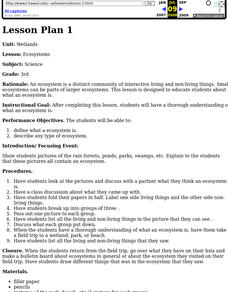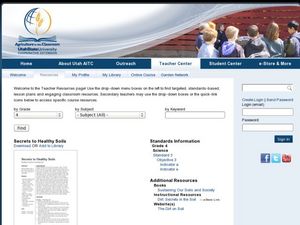Curated OER
Worming Your Way Through the Soil
Students study soil, living and non-living particles in the soil, and learn about composting. In this soil study lesson, students study soil samples and discuss the living and non-living components of the soil. Students classify the...
Curated OER
KWL Chart: Living and Non Living
In this KWL chart worksheet, students fill in this graphic organizer about living and non-living things. Students complete 3 sections in the chart.
Curated OER
Scavenging the Sandy Shore
Students explore oceanography by examining a beach. In this living things lesson plan, students define the terms abiotic and biotic and practice identifying living and non-living things that have been previously found on a beach....
Curated OER
What is Life?
Students investigate the characteristics of living things. In this life science instructional activity, students examine several living and non-living specimens. Students determine which things are living and non-living.
Curated OER
Reconstructing the Squares
Students visit an outdoors area and mark out a square on the ground that they examine, looking for living and non-living things. They make a model or drawing of the findings from the actual square.
Curated OER
Wetlands
Third graders examine how an ecosystem is a distinct community of interactive living and non-living things.
Curated OER
Characteristics of Living Things
Student use the scientific method to experiment with worms. In this characteristics of living things lesson, learners predict and examine the reactions of worms to dry and wet soil. Students share their findings.
Curated OER
Assignment on Life Processes
In this life processes learning exercise, 8th graders create a children's book about the 7 functions of life that all living organisms have, complete with examples of living and non-living things.
Larson Lab
Animal Classification
How are animals classified? Scholars explore animal classification by observing non-living and living specimens. They learn how to organize animals into vertebrates and invertebrates and identify the five vertebrate groups: mammals,...
Curated OER
Get a Half Life!: Student Worksheet
Upper elementary or middle schoolers will explore non-linear functions, graphing, and the curve of best fit through real-life data collection and trial analysis. They explore the concept of half-life and radioactive decay using M&Ms,...
Curated OER
The Plant Food Factory
Plants need sun and water to survive. Let kids discover these facts by reading a block of informational text and considering a scientific quandary. They read the text, then use the information to complete a two-part question about plant...
Curated OER
Plant Groups
Compare different types of leaves in a science exploration. First, third graders identify common characteristics of various plants, such as daisies, fir needles, and cypress leaves. They then determine if the plants in each group are...
Curated OER
Plant Life Cycles
Follow the life cycle of a dandelion with a lab sheet for kindergartners. They learn about the order of events in a dandelion's life, then put the stages of life in order. Can they describe the life cycle of a pumpkin? For extra...
Curated OER
Grocery Shopping
Using an adaptive shopping list, special needs students take a trip to the grocery store. Instead of words, their list contains pictures of the items they need to find and purchase at the store. They run through several practice and...
Curated OER
Living or Nonliving
Third graders brainstorm a list of the characteristics of living and nonliving organisms. Individually, they find four nonliving and living items and the characteristics that make them fit into one of the categories. To end the...
Curated OER
It's Alive
First graders critically analyze living and nonliving objects, then develop a list of characteristics to classify objects on a science walk. They make a book to close out the lesson.
Curated OER
Secrets to Healthy Soil
Fourth graders explore needed mineral nutrients for healthy soil. In this soil lesson, 4th graders investigate how living and nonliving elements combine to contribute to fertile soil development.
Curated OER
Food Chain/Food Web
Students explore ecosystems. In this ecology lesson, students read an article explaining ecosystems. Students create a visual organizer with index cards using components of various ecosystems.
Curated OER
Investigation 3 - Terrariums / Aquariums
Third graders create aquariums or terrariums to explain how creatures depend on living and nonliving things.
Curated OER
Living and Non-Living Things
In this worksheet on living and non-living things, students categorize items, cutting and pasting their pictures under the correct heading.
Curated OER
Science - What Can Living Things Do
In these living things worksheets, students write true or false for the sentences about living things. Students answer the questions about living things and choose the words that best describe the statements about living things.
Curated OER
Science - What do living things need?
In this living things worksheet, students answer questions that ask what living things need. Students answer 10 questions in the true and false and short answer format.
Denver Art Museum
The Poetry in Non-Events
The photograph, Nellie and her Italian Soda is viewed and discussed by the class. They are instructed to use the photograph as inspiration to write a poem about non-events, or things that are beautiful in every day life. Pupils use a...
Curated OER
Non-Defining Relative Pronouns Exercise
Writing flows better with complex and compound sentences. Teach your learners how to combine sentences using relative clauses. This activity has 10 questions, but there are no examples provided. Consider providing at least a few examples...
Other popular searches
- Living and Non Living Things
- Living and Non Living Things
- Non Living
- Non Living Things
- Living vs Non Living Things
- Ocean Explorers Non Living
- Non Living Components
- Non Living Organisms
- Living Non Living Things
- Living Non Living Things
- Non Living Things
- Laving and Non Living Things

























